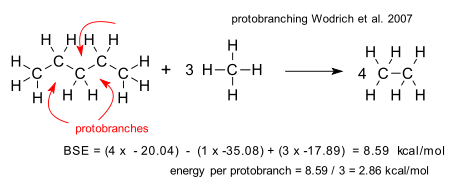Gronert vs protobranching
21 May 2009 - Thermochemistry
In the universe of simple hydrocarbons, branches are stabilizers: isobutane is more stable than n-butane and neopentane is more stable than isopentane. As to the reason why, there is not exactly agreement. Classic explanations point to stabilizing C-C-C, H-C-C and H-C-H 1,3 interactions based on hyperconjugation. In 2006 Scott Gronert turned things upside down and proposed a group additivity model in which these interactions are in fact described as destabilizing with other factors more stabilizing than previously thought and preserving the balance (DOI). In his view this 1,3 repulsion is simply a case of steric hindrance and can only be destabilizing.
In 2007 a group around Schleyer introduced a novel concept called protobranching, defined as the net stabilizing 1,3-alkyl-alkyl interactions existing in normal, branched, and most cycloalkanes (methane and ethane excluded) that they used to reassess several important energy contributions to thermodynamical stability such as resonance energy (DOI). This concept of course is a direct assault on the Gronert model and in a recent article called The Folly of Protobranching - generously sprinkled with exclamation marks - the man himself counters (DOI).

In the Schleyer model, propane has one protobranch, two protobranches can be found in n-pentane, three in isobutane and 6 in neopentane. Its energy content can be calculated from the simple hypothetical reaction of neopentane with methane to give ethane. In this isodesmic reaction (without any real life significance) the type of bonds in the participating molecules do not change but in the reaction product all protobranches are removed. The enthalpy change that can be calculated from the heat of formation - you do not have to own a lab for this kind of research , a pocket calculator suffices - can therefore be entirely attributed to the effect of protobranching, arriving at an enthalpy per protobranch of 2.28 kcal/mol.
According to Schleyer, the protobranching model has some serious consequences for several commonly held stability beliefs. Take for instance cyclopropane whose strain energy of 27 kcal/mol can be calculated from the isodesmic reaction of cyclopropane with 3 eq. of ethane to form 4 eq. of propane. Problem is that in this reaction the reaction product is burdened with protobranches and therefore this strain energy is overestimated by 10 kcal/mol. Likewise the resonance energy found for benzene (36 kcal/mol) is actually twice as high when correcting for perturbing effects not only of protobranching but also that of regular conjugation and hyperconjugation.
Enter Gronert. He argues that additivity schemes involving heats of formation are a a data-fitter's dream. He also recalls that in simple alkenes CCC angles are expanded at the expense of HCH and HCC angles, clearly establishing that 1,3-interactions are repulsive. An attractive force would require the the invention of a heretofore-unknown intramolecular interaction. Gronert also wonders why protobranching is nonexistent in intermolecular interactions or in alkenes where it is replaced by hyperconjugation. Protobranching is also sending out confusing messages: ''Do the similar stabilization energies of the C7 species norbornane (13.8 kcal/ mol) and n-heptane (14.1 kcal/mol) imply that they have approximately the same level of strain?".
This debate is no doubt going to be continued and feels similar to the phenanthrene hydrogen bonds debate. It certainly belongs in the unsolved problems in chemistry category.
